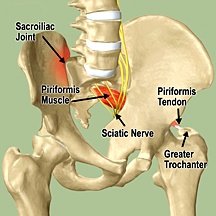5 Ways to Treat Sacroiliac Joint Pain
Dysfunction in the sacroiliac joint, or SI joint, is thought to cause low back and/or leg pain. The leg pain can be particularly difficult, and may feel similar to sciatica or pain caused by a lumbar disc herniation.
The sacroiliac joint lies next to the bottom of the spine, below the lumbar spine and above the tailbone (coccyx). It connects the sacrum (the triangular bone at the bottom of the spine) with the pelvis (iliac crest).
While it is not clear how the pain is caused, it is thought that an alteration in the normal joint motion may be the culprit that causes sacroiliac pain. This source of pain can be caused by either:
- Too much movement (hypermobility or instability): The pain is typically felt in the lower back and/or hip and may radiate into groin area.
- Too little movement (hypomobility or fixation): The pain is typically felt on one side of the low back or buttocks, and can radiate down the leg. The pain usually remains above the knee, but at times pain can extend to the ankle or foot. The pain is similar to sciatica, or pain that radiates down the sciatic nerve and is caused by a radiculopathy.
Treatments for sacroiliac joint dysfunction (SI joint pain) are usually conservative (meaning non-surgical) and focus on trying to restore normal motion in the joint.
Typical treatments for sacroiliac joint dysfunction include:
1. Ice, heat, and rest
Initial treatment recommendations will typically include use of ice or cold packs, applied in 15 to 20 minute intervals as needed to reduce inflammation in the area, along with rest to reduce irritation. Depending on the duration of sharp, intense pain, ice can be continued anywhere between 2 days to 2 weeks. Once the inflammation is less, gradual return to normal activities may be advisable. Application of heat (such as a heat wrap or hot bath) may help the healing process, but not during the acute, high intense pain time frame.
2. Medications
First line of treatment often may include pain medications (such as acetaminophen), as well as anti-inflammatory medications (such as ibuprofen or naproxen) to reduce the swelling that is usually contributing to the patient’s pain.
3. Chiropractic manipulations
Manual manipulation provided by a chiropractor, osteopathic doctor, or other qualified health practitioner may help. This can be highly effective when the SI joint is fixated or “stuck.” It may be irritating if the SI joint is hypermobile. This is accomplished by a number of methods including (but not limited to): side-posture manipulation, drop technique, blocking techniques, and instrument guided methods. Your health care provider will choose a method they feel is most appropriate for your specific case.
4. Supports or braces
When the SI joint is “hypermobile” or too loose, an “orthotic” or brace about the size of a rather wide belt can be wrapped around the waist and pulled snugly to stabilize the area. This can sometimes be very helpful at times when the joint is inflamed or painful. When it calms down, the orthotic can be weaned away.
5. Physical therapy and exercise
Controlled, gradual physical therapy may be helpful to strengthen the muscles around the sacroiliac joint and appropriately increase range of motion. In addition, any type of gentle, low impact aerobic exercise will help increase the flow of blood to the area, which in turn stimulates a healing response. For severe pain, water therapy may be a reasonable option, as the water provides buoyancy for the body and reduces stress on the painful joint.
In my next blog post, I’ll discuss surgical solutions for treating sacroiliac joint pain. For more information, and to schedule an appointment with Dr. Sharma, please click here.

Categories
Archives
Contact Dr. Mudit Sharma
Phone: (571) 921-4877
Toll Free: (855) 774-6334
Monday – Thursday: 8am – 4pm
Friday: 8am – 2pm
Fredericksburg
4604 Spotsylvania Parkway, Suite 300 Fredericksburg, VA 22408
Manassas
8650 Sudley Road, Suite 315
Manassas, VA 20110-4418

